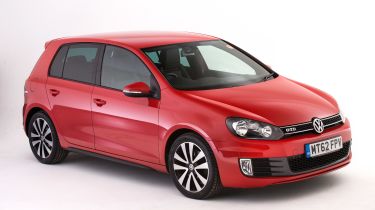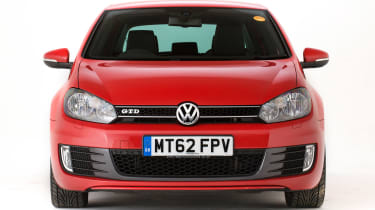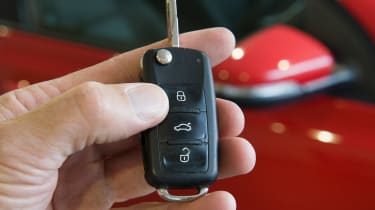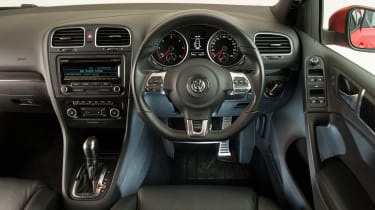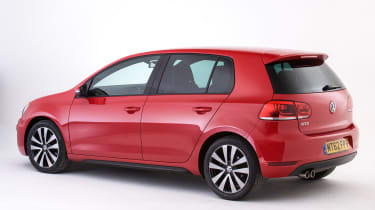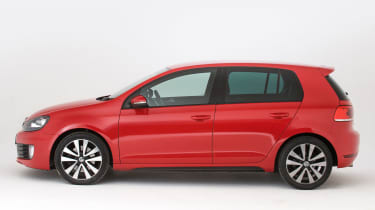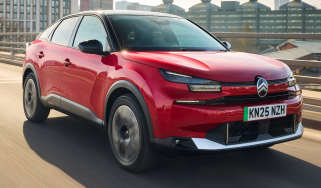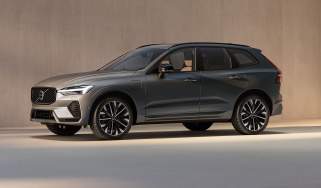Used Volkswagen Golf (Mk6, 2009-2013) review
A full used buyer’s guide on the Volkswagen Golf covering the Golf Mk6 (2009-2013)
History
The sixth-generation Golf reached the UK in January 2009, in three or five-door hatch forms. There were three trim levels (S, SE or GT) and four petrol engines (79bhp 1.4, 121bhp or 158bhp 1.4 TSI and 101bhp 1.6), plus a 2.0 TDI diesel in 108bhp or 138bhp guises. The GTI hot hatch appeared in May 2009, while a month later the 168bhp GTD diesel arrived – but both blend great performance with surprising economy.
An ultra-frugal 1.6 TDI debuted in September 2009; in BlueMotion form it claimed 62.8mpg. Yet within weeks, VW had raised the bar, launching a 99g/km 74.3mpg BlueMotion model. The 261bhp Golf R appeared in October 2009, the Match replaced the SE in May 2010, and the GTI Edition 35 debuted in September 2011.
Prices
A five-year-old Golf Mk6 will be between £7,500 and £15,000 depending on specification.
Visit our Find a Car service for the latest used Volkswagen Golf Mk6 prices and deals or use our free car valuation tool to view the latest market value of a specific car.
Volkswagen Golf Mk6 reviews
Volkswagen Golf in-depth review
Volkswagen Golf 1.2 TSI review
Volkswagen Golf 1.4 TSI review
Volkswagen Golf 1.6 TSI review
Volkswagen Golf 1.6 TDI BlueMotion review
Volkswagen Golf 2.0 TDI review
Volkswagen Golf GTI review
Volkswagen Golf GTD review
Volkswagen Golf R review
Volkswagen Golf Estate review
Volkswagen Golf GTD long-term test review
Which one should I buy?
The TSI and TDI are zesty and economical; the regular 1.4-litre petrol is lacklustre but fine if you’re in no hurry. You’ll get more for your money if you buy a petrol-engined Golf, and the DSG dual-clutch auto transmission is one of the slickest around – which is why (unusually) CO2 emissions don’t vary much between manual and automatic boxes.
Entry-level S trim features remote central locking, powered front windows, a four-speaker stereo and air-con. Twist adds alloy wheels, four more speakers and sports suspension. SE (later Match) brings powered rear windows, Bluetooth, cruise control, an auto-dimming rear view mirror, parking sensors front and rear, as well as automatic lights and wipers. The GT gets sportier trim, 17-inch alloys and sports suspension.
Alternatives to the Volkswagen Golf Mk6
A key rival to the Golf is its Audi A3 sister car. It uses the same platform and mechanicals, but has an even plusher cabin. Meanwhile, the BMW 1 Series comes in a variety of bodystyles, is extremely well built and has some of the most efficient engines around.
Used - available now
Matching the VW on image if not practicality is the MINI; rear seat access is awkward and the boot is small, but it’s good to drive and well built. If practicality is more important, don’t overlook the Ford Focus; it’s a cracking car that’s great to drive, well equipped and reliable. Plus, with supply plentiful, it’s far cheaper than the Golf. The Vauxhall Astra and Peugeot 308 major on value, but aren’t as solid or good to drive.
What to look for:
Alarm
Check the blipper, as the alarm system can be temperamental, going off for no reason. It’s usually simply a question of getting the ECU’s software updated by a dealer.
Phone
On some early examples, the Bluetooth phone system wouldn’t recognise most types of mobile; it canbe sorted now, but the fix can be pricey.
Cabin
Squeaks and rattles from inside the Golf aren’t unknown. It’s often simply down to the back of the rear seat not being properly latched, though.
Suspension
Creaks from the front underside are down to the suspension bushes drying out. And the noise is usually most pronounced when the weather is warm.
Interior
Within the mid-sized family hatch market, the Golf has long set the benchmark for cabin quality and clarity. That’s certainly the case here; the car feels fantastically solid and everything is beautifully laid out. Boot space is left trailing by some rivals, though, with a 350-litre load bay expanding to only 1,305 litres.
Running costs
Owners can choose between fixed-interval or variable servicing. The former requires maintenance every year or 10,000 miles; the latter every year or up to 18,600 miles, depending on how the car’s driven. All Mk6 Golfs have reached their third birthday, so are eligible for cut-price servicing. A minor check-up is £149; a major one £299.
All diesels need a fresh cambelt every four years or 130,000 miles (at £399); the 1.4 and 1.6-litre petrols also have a belt, but there’s no set schedule. Instead, it’s checked at each service and replaced only when it’s showing signs of wear. The brake fluid should also be renewed after three years, then every two years, at £59.
Recalls
There have been three recalls for the sixth-generation Golf, including the current emissions campaign, which will bring a mixture of software and hardware fixes.
You can check whether a specific car is affected here. Before this, in December 2011, 2.0 TDIs built up to that point were called back over fuel leaks. The first Mk6 recall came in December 2009. DSG models made up to August 2009 could suffer a loss of drive due to a software glitch.
Driver Power owner satisfaction
The Golf Mk6 didn’t make the top 150 of our Driver Power 2016 satisfaction survey. but it ranked 89th in 2015. The car finished 83rd for build quality, 88th for handling, 96th for ride quality, 99th for ease of driving and 90th for practicality. Its lowest score was 186th for reliability, which will really disappoint VW bosses.
Verdict
Used Golfs have always been in demand, and the emissions scandal seems to have made no difference; trade expert CAP says there’s been no slide in values. That’s good news for sellers, but not if you’re buying, as you’ll have to dig as deep as ever to secure one of these understated family cars.
With three or five-door hatches and a roomy estate, plus a wide range of engines and trims, it’s no wonder this is one of the UK’s favourite cars. Yet as our Driver Power survey shows, you need to buy with care; build quality may be strong, but the Golf isn’t always as reliable as you might think.
Click through to page three for our full buyer's guide on the Volkswagen Golf Mk5 sold from 2003 to 2009...

